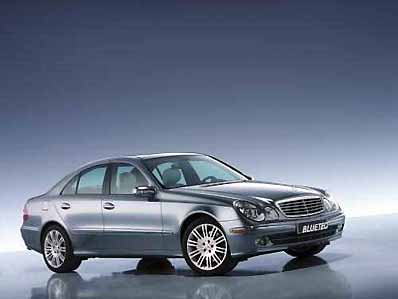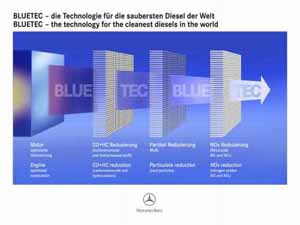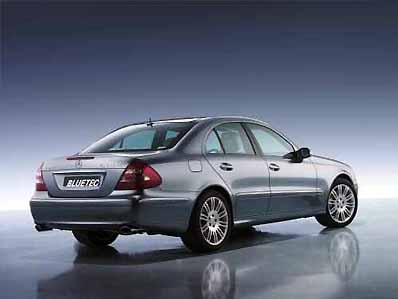
The
Stuttgart-based brand
Ultra Low
Sulphur Diesel (ULSD)

"Ultra Low Sulfur Diesel"
(ULSD)
ZUR DEUTSCHEN
VERSION |
Mercedes-Benz E 320 BLUETEC begins the Diesel
campaign in the USA
Stuttgart - To
coincide with the conversion of up to 76,000 US filling stations to clean
Diesel fuel with a sulphur content below 15 ppm, Mercedes Benz is commencing
sales of the E 320 BLUETEC in the USA and Canada in one week's time.
 Ultra Low Sulphur Diesel (ULSD) allows
the use of trail-blazing BLUETEC technology, making the E 320 BLUETEC the
world's cleanest Diesel car. The E 320 BLUETEC is the first and only Diesel
vehicle worldwide able to better the American BIN 8 exhaust emissions standard,
which is extremely stringent - particularly in terms of nitrogen oxide emissions.
The E 320 BLUETEC will be available for sale in the USA (45 states) and Canada,
and uses up to 30 percent less fuel than comparable petrol-engine vehicles
in North America. Owing to its enormous operating range of up to 1200 km
on one full tank, the E 320 BLUETEC is exceptionally well cut-out for US
driving conditions. The latest J.D. Power study "Global Outlook For Diesel"
forecasts that Diesels will account for more than 15 percent of new registrations
in North America by 2015. In the light of this, Mercedes-Benz will systematically
expand its BLUETEC range. The company has announced that it intends to offer
three further BLUETEC models in the R, ML and GL-Class - meeting the even
more stringent BIN 5 standard - in all 50 US states as early as 2008. BLUETEC
is a modular emissions control system that reduces nitrogen oxide levels.
These are the only exhaust components from Diesel engines which, due to the
principles of Diesel engineering, still exceed the levels in petrol units.
Mercedes-Benz has developed two versions of BLUETEC: Ultra Low Sulphur Diesel (ULSD) allows
the use of trail-blazing BLUETEC technology, making the E 320 BLUETEC the
world's cleanest Diesel car. The E 320 BLUETEC is the first and only Diesel
vehicle worldwide able to better the American BIN 8 exhaust emissions standard,
which is extremely stringent - particularly in terms of nitrogen oxide emissions.
The E 320 BLUETEC will be available for sale in the USA (45 states) and Canada,
and uses up to 30 percent less fuel than comparable petrol-engine vehicles
in North America. Owing to its enormous operating range of up to 1200 km
on one full tank, the E 320 BLUETEC is exceptionally well cut-out for US
driving conditions. The latest J.D. Power study "Global Outlook For Diesel"
forecasts that Diesels will account for more than 15 percent of new registrations
in North America by 2015. In the light of this, Mercedes-Benz will systematically
expand its BLUETEC range. The company has announced that it intends to offer
three further BLUETEC models in the R, ML and GL-Class - meeting the even
more stringent BIN 5 standard - in all 50 US states as early as 2008. BLUETEC
is a modular emissions control system that reduces nitrogen oxide levels.
These are the only exhaust components from Diesel engines which, due to the
principles of Diesel engineering, still exceed the levels in petrol units.
Mercedes-Benz has developed two versions of BLUETEC:
 in the E-Class an oxidation-type catalytic
converter and particulate filter are combined with an improved, extremely
durable NOx trap system and an additional SCR catalytic converter. The second
BLUETEC version is even more efficient. Here, AdBlue, a non-toxic aqueous
solution, is injected into the exhaust-gas stream, causing ammonia to be
released. In the downstream SCR catalytic converter the ammonia then converts
up to 80 percent of the nitrogen oxides into the harmless natural products
of nitrogen and water. The specific vehicle concept and weight as well as
the deNOx requirements determine which BLUETEC system is used. From October
21 this BLUETEC technology will be subjected to an endurance test of a very
special kind, when 33 E-Class cars including three E 320 BLUETEC models embark
on a journey from Paris to Peking. Over the course of 26 days each of these
vehicles will cover 13,600 kilometres under extreme conditions on a journey
which will take them across eight national borders. in the E-Class an oxidation-type catalytic
converter and particulate filter are combined with an improved, extremely
durable NOx trap system and an additional SCR catalytic converter. The second
BLUETEC version is even more efficient. Here, AdBlue, a non-toxic aqueous
solution, is injected into the exhaust-gas stream, causing ammonia to be
released. In the downstream SCR catalytic converter the ammonia then converts
up to 80 percent of the nitrogen oxides into the harmless natural products
of nitrogen and water. The specific vehicle concept and weight as well as
the deNOx requirements determine which BLUETEC system is used. From October
21 this BLUETEC technology will be subjected to an endurance test of a very
special kind, when 33 E-Class cars including three E 320 BLUETEC models embark
on a journey from Paris to Peking. Over the course of 26 days each of these
vehicles will cover 13,600 kilometres under extreme conditions on a journey
which will take them across eight national borders. |
BLUETEC: Highly successful in commercial
vehicles - the result of a clear strategy
 The BLUETEC technology developed by
Mercedes-Benz benefits from the company's extensive know-how in building
low-emission commercial vehicles, where this technology has already proved
highly successful since early 2005 and is meantime available in all model
series. A total of 33,000 Mercedes-Benz trucks and buses from the brands
Mercedes-Benz and Setra have already been sold with BLUETEC. Mercedes-Benz
first demonstrated the potential of this new emissions technology for passenger
cars in June 2005 in Washington when it displayed the Mercedes-Benz bionic
car, a concept vehicle based on findings from bionic research. From January
2005, DaimlerChrysler began a public dialogue on the subject of this innovative
technology when it introduced a total of 6 BLUETEC showcars in the E, CLS,
R, ML and GL-Class, as well as a Chrysler Grand Cherokee BLUETEC. In 1936
Mercedes-Benz introduced the world's first series production Diesel car into
the market, and has continued to set standards in this field with numerous
innovative Diesel technologies. The BLUETEC technology developed by
Mercedes-Benz benefits from the company's extensive know-how in building
low-emission commercial vehicles, where this technology has already proved
highly successful since early 2005 and is meantime available in all model
series. A total of 33,000 Mercedes-Benz trucks and buses from the brands
Mercedes-Benz and Setra have already been sold with BLUETEC. Mercedes-Benz
first demonstrated the potential of this new emissions technology for passenger
cars in June 2005 in Washington when it displayed the Mercedes-Benz bionic
car, a concept vehicle based on findings from bionic research. From January
2005, DaimlerChrysler began a public dialogue on the subject of this innovative
technology when it introduced a total of 6 BLUETEC showcars in the E, CLS,
R, ML and GL-Class, as well as a Chrysler Grand Cherokee BLUETEC. In 1936
Mercedes-Benz introduced the world's first series production Diesel car into
the market, and has continued to set standards in this field with numerous
innovative Diesel technologies. |
| DaimlerChrysler Communications,
Stuttgart (Germany), Auburn Hills (USA), October 09, 2006 |
BACK TO TOP |
